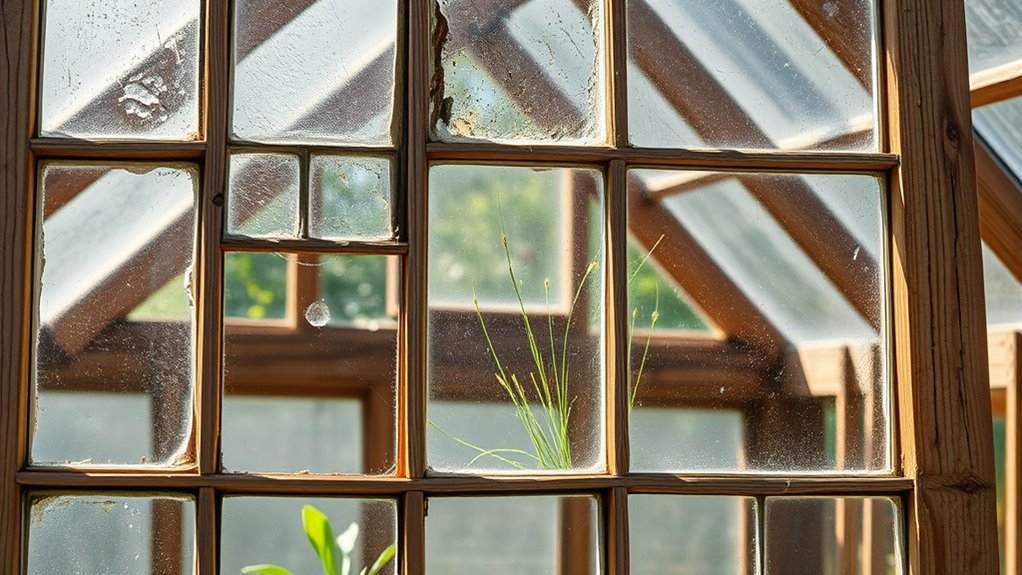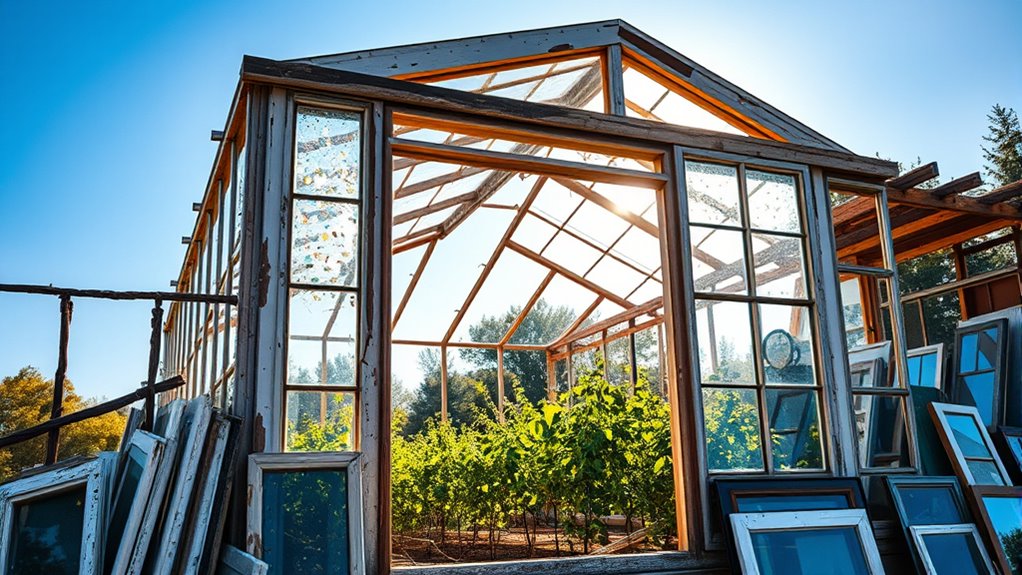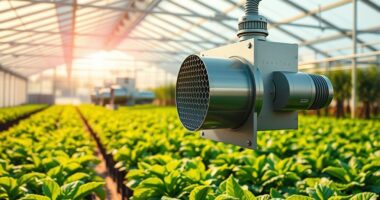Building a greenhouse with recycled windows is an eco-friendly and budget-smart project that allows you to maximize natural sunlight and reduce waste. Position the windows carefully to catch sunlight during peak hours and seal any gaps to keep pests out. Use mesh screens on vents for pest control and consider adding adjustable vents or fans. This sustainable design creates a healthy environment for your plants while promoting eco-conscious gardening—keep exploring for detailed tips and ideas.
Key Takeaways
- Select and clean recycled windows to ensure durability and proper sealing for greenhouse construction.
- Position windows to maximize sunlight exposure and solar gain for natural temperature regulation.
- Seal gaps and install fine mesh screens to prevent pests while maintaining airflow inside the greenhouse.
- Incorporate adjustable vents or small fans to optimize airflow and temperature control sustainably.
- Use recycled windows as an eco-friendly, cost-effective alternative that promotes sustainability and long-term plant health.

Transforming recycled windows into a functional greenhouse is an eco-friendly and cost-effective way to grow your favorite plants. By repurposing old windows, you not only reduce waste but also create a sustainable environment for your garden. The key to making your greenhouse thrive lies in harnessing natural resources like solar energy and implementing effective pest control methods. Solar energy plays a crucial role in maintaining the ideal temperature inside your greenhouse. Position your recycled windows to maximize sunlight exposure, especially during peak hours. Clear glass or plastic panes are perfect for capturing as much solar radiation as possible, warming the interior during cooler months and providing consistent light for your plants. Installing adjustable vents or small fans can help regulate airflow, preventing overheating and ensuring your plants receive fresh air. This way, you make optimal use of the sun’s energy, reducing the need for electrical heating or cooling systems, which saves money and energy in the long run. Additionally, understanding how attention impacts creativity can help you stay focused and motivated throughout your gardening project.
Pest control is another vital aspect to consider when building and maintaining your recycled window greenhouse. While natural sunlight and ventilation support plant health, pests can quickly become a problem if not managed properly. To keep unwanted visitors out, you should seal any gaps or cracks in the window frames and use fine mesh screens on ventilation openings. These screens act as a barrier against insects and other pests, preventing infestations without resorting to chemical pesticides. Regular inspection is essential; catching signs of pests early allows you to take swift action, such as removing affected plants or applying organic pest deterrents. Introducing beneficial insects like ladybugs or predatory mites can also help control common pests naturally, maintaining a healthy ecosystem inside your greenhouse. Remember, the goal is to create a balanced environment where your plants can flourish without the constant threat of pests.
Combining solar energy optimization with effective pest control strategies ensures your recycled window greenhouse remains productive and sustainable. By positioning your windows thoughtfully, you maximize sunlight absorption, while sealing and screening prevent pest intrusion. Your success depends on attention to these details, which foster a thriving, eco-friendly space for your plants. Building a greenhouse from recycled windows is not just an environmentally conscious project but also a rewarding one that allows you to grow plants year-round while reducing your carbon footprint. With a little planning and effort, you’ll create a lush, sustainable garden that benefits both you and the planet.
Frequently Asked Questions
How Do I Ensure Proper Insulation With Recycled Windows?
To guarantee proper insulation with recycled windows, focus on thermal sealing around each window frame. Use weatherstripping or caulk to eliminate gaps, preventing heat loss. Reinforce the window framing with sturdy materials to keep everything in place and reduce drafts. Regularly check for leaks or cracks, and reseal if necessary. Proper thermal sealing combined with strong window framing helps maintain a consistent temperature inside your greenhouse, boosting efficiency.
What Safety Precautions Are Necessary During Construction?
You should wear personal protective gear like gloves, goggles, and sturdy boots to prevent injuries during construction. Always follow tool safety instructions, keeping tools in good condition and using them correctly. Be cautious when handling glass or sharp materials, and make sure the work area is clear of hazards. Communicate with others on-site, and take breaks to avoid fatigue. These precautions keep you safe and help your project go smoothly.
How Can I Prevent Leaks and Drafts in the Greenhouse?
Think of your greenhouse as a cozy nest, and weatherproofing techniques as its shield. To prevent leaks and drafts, you should use effective window sealing methods like weatherstripping and caulking around edges. Applying clear silicone sealant on any gaps also helps. Regularly check for wear and tear, and re-seal as needed. This keeps the warmth in and drafts out, creating a snug environment for your plants to thrive.
What Type of Foundation Is Best for Recycled Window Greenhouses?
You should use a concrete or treated wood foundation for your recycled window greenhouse because it offers excellent foundation stability. Start by preparing the soil properly, removing weeds, and leveling the ground to guarantee a solid base. This foundation choice prevents shifting or settling, which can crack or damage your recycled windows. Proper soil preparation and a sturdy foundation help your greenhouse stay durable and secure over time.
How Do I Choose the Right Recycled Windows for Insulation?
You should choose recycled windows with sturdy window framing, ensuring they fit tightly to prevent drafts. Look for glass durability; opt for double or triple-pane windows that offer better insulation and resist breakage. Avoid damaged or cracked glass, as this reduces efficiency. Prioritize windows with weather-resistant frames, like vinyl or metal, to withstand outdoor conditions. This way, your greenhouse stays warm and durable, making your gardening efforts more successful.
Conclusion
By repurposing old windows, you’ve opened the door to a lush sanctuary where nature and creativity intertwine. Your greenhouse isn’t just a structure; it’s a blossoming monument to sustainability and hope. Every pane reflects your dedication, turning recycled glass into a fortress of growth. With each sunrise, your efforts bloom into vibrant life—proof that with a little ingenuity, you can transform waste into a thriving paradise. The future of your garden starts with these humble, recycled windows.









